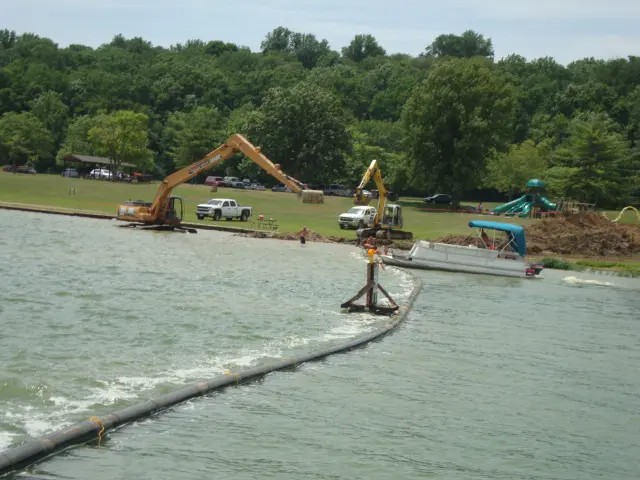


Lake Weed Removal
Lake Weed Removal Swampthing.us # 1 local company for Lake Weed Control, Aquatic Services & Dredging
Lake Weed Control and Lake Weed Removal let American Dredge and Aquatic Weed Control Company handle all of your needs for Aquatic Services and Aquatic Control. Let us be your first choice in lake weed removal, organic aquatic control, aquatic weed harvesting, and invasive aquatic weed control of lake weeds. We are a nationally recognized aquatic control and dredging company offering services in your backyard MI, IN, OH, WI, IL, KY, TN, AL, NC, SC, GA, MN, IA, CO, TX, anywhere. We have a large fleet of equipment to handle your large project, even in Alaska. Contact our office at 1 (855) 305-0233 for lake weed control, and aquatic weed harvesting services in your area.
We also remove cattails from lakes, ponds, canals, and lakefronts with our Hydro-rake.
(please make sure you get a chance to read further down the page about Dissolved Oxygen)
Invasive Aquatic Control, Removal and eradication of invasive aquatic weeds.
Invasive Aquatic Weeds have become a problem throughout the Nation. We have a variety of equipment and services to control Invasive Aquatic vegetation. Here is one of our crews working on invasive aquatic weed control of Phragmites in Toledo, Ohio. We have developed some specialized equipment that allows us
to go from land to water control or harvest phragmites, which were sprayed first to keep from spreading. We have programs to control, cut, spray, or remove invasive aquatic weeds: Phragmites, Purple Loosestrife, Eurasian milfoil, Elodea, etc., and we will travel anywhere MI, IN, OH, WI, IL, KY, TN, AL, NC, SC, GA, MN, IA, CO, TX contact us 1 (855) 305-0233.
These are some before pictures of cutting Phragmites, they are very aggressive growing and push out native plants like cattails.
Our machines mechanically harvest the phragmites near Lake Erie
End of project for invasive aquatic weed control of phragmites in Toledo, Ohio. We travel all over the nation for similar projects. Contact www.swampthing.us to allow us to control your invasive aquatic weeds.
Aquatic Weed Harvesting
Aquatic weed removal or lake weed removal for MI, IN, OH, WI, IL, KY, TN, AL, NC, SC, GA, MN, IA, CO, TX contact us at 1 (855) 305-0233.
Periodic weed harvesting of shoreline areas will in many instances prove to be an effective means of aquatic plant control. The rooted AQUATIC WEEDS must produce sufficient food in their leaves to maintain their root systems. Frequent cuttings of the leaves will eventually lead to the death of the root system. Like weeding the garden, it is necessary to watch for the early development of potential problems and remove the AQUATIC WEEDS as they become established, and before they spread over large areas. It reduces the amount of Biomass on the bottom of the lake, more biomass equals more nutrients for plant growth.
The more Aquatic Weeds you remove during the spring, summer, and fall, the less AQUATIC WEEDS that will be on your lakefront. The problem with a lot of chemicals, they kill the lake weeds but create biomass on the bottom of the lake, which can create a “Mucky” type bottom. More nutrients can lead to Algae Blooms, and then they have to apply more chemicals. You’re adding mass to the bottom of your lake, losing depth. Aquatic Weed Harvesting can actually improve your ecosystem on your lake when managed properly. Creating better breeding grounds for fish and wildlife. It is like giving your lakefront a healthy haircut. It is about keeping your lake in balance, keeping it healthy for you and future generations to enjoy. Let us do cattail lake weed removal for you.
Mechanical Weed Harvesting can be a very selective method of LAKE weed removal and can be used to only remove a portion of the aquatic plants. The more selective methods can be used to maintain open boat channels through native aquatic plant stands, from docks to open water, without opening the bottom to invasion of non-indigenous species. A lot of Chemicals deteriorate the plant and leave the bottom open for invasive aquatic plant species. Michigan has seen several Aquatic Invasive Species in its lakes. Eurasian Milfoil



Dissolved Oxygen
Use of Aquatic Herbicides and Oxygen Depletion
Treating a heavy infestation of aquatic weeds with a herbicide during the summer can cause oxygen depletion. The rapid decomposition of a mass of aquatic weeds depletes dissolved oxygen like a bloom die-off. Also, treating weed infestations with herbicides in hot weather is risky.
Dissolved oxygen is probably the single most important water quality factor that lake/pond managers need to understand. Oxygen dissolves in water at very low concentrations. Our atmosphere is 20% oxygen or 200,000 ppm, but seldom will a pond have more than 10 ppm oxygen dissolved in its water. Dissolved oxygen concentrations below 3 ppm stress most warm water species of fish, and concentrations below 2 ppm will kill some species. Often, fish that have been stressed by dissolved oxygen concentrations in the range of 2 or 3 ppm will become susceptible to disease.
Oxygen dissolves into water from two sources: the atmosphere and from plants in the water. The primary source of oxygen for a lake/pond is from microscopic algae (phytoplankton) or submerged plants. In the presence of sunlight, these produce oxygen through photosynthesis and release this oxygen into the pond water. At night and on very cloudy days, algae and submerged plants remove oxygen from the water for respiration. During daylight hours, plants normally produce more oxygen than they consume, thus providing oxygen for the fish and other organisms in the pond.
Oxygen depletion is the most common cause of fish kills in lakes/ponds. Most oxygen deletions occur in the summer months because 1) warm water holds less dissolved oxygen than cool or cold water, and 2) because the pond’s oxygen demand is greater in warm water than in cold water. Fish kills from oxygen depletion can range from “partial” to “total”. In a partial kill, the dissolved oxygen level gets low enough to suffocate sensitive species and large fish, but many small fish and hardy species survive. Most oxygen depletion causes partial fish kills; total fish kills are relatively rare in recreational ponds, except for those with extremely high fish populations (>1,000 pounds/acre). The following are descriptions of the most common types of oxygen depletion.
Excessive Phytoplankton
The abundance of planktonic algae (very green water) in a pond is generally related to the amount of nutrients present in the water. Nutrients can wash into the pond from woods, pastures, fields, human activities (too much herbicide use, decomposing aquatic vegetation) in the watershed, or come from lake/pond fertilization. Generally, the more nutrients, the more planktonic algae (or other aquatic plants) will grow or bloom. Although phytoplankton is good from an abundance of natural food and oxygen-producing standpoint, it can become too abundant or excessive. When phytoplankton become so abundant that water visibility is limited to less than 12 inches, there is a danger of oxygen depletion. These heavy or dense blooms use large amounts of dissolved oxygen at night and on very cloudy/overcast, windless days, causing oxygen depletion and fish kill. This problem is often a consequence of overfertilizing, overfeeding, or excessive nutrients.
Phytoplankton Die-off
Phytoplankton populations, or blooms, can grow rapidly, particularly on sunny days when the water is warm and nutrients are available. Alternatively, they can die off quickly, especially in the spring and fall, as water temperatures change rapidly with weather fronts. However, a bloom die-off can occur at any time of the year with little or no warning.
Typically, during a bloom die-off, the color of the water will start to change. Leading up to a bloom die-off, the pond water may have a “streaky” appearance. Streaks of brown or gray-black through the otherwise green water of the pond is an indication that the algae are starting to die. As the die-off progresses, the whole pond will turn from green to gray, brown, or clear. The pond water will typically clear after a die-off as the dead algae settle to the bottom.
Plankton die-offs cause rapid oxygen depletion for two reasons: 1) the remaining dissolved oxygen is consumed by aerobic bacteria and fungi in the process of decaying the dead algae, and 2) few live phytoplankton remain to produce more oxygen. Secchi disks can be used to monitor bloom densities. Any bloom that reduces visibility in the pond to 12 inches or fewer may cause oxygen problems.
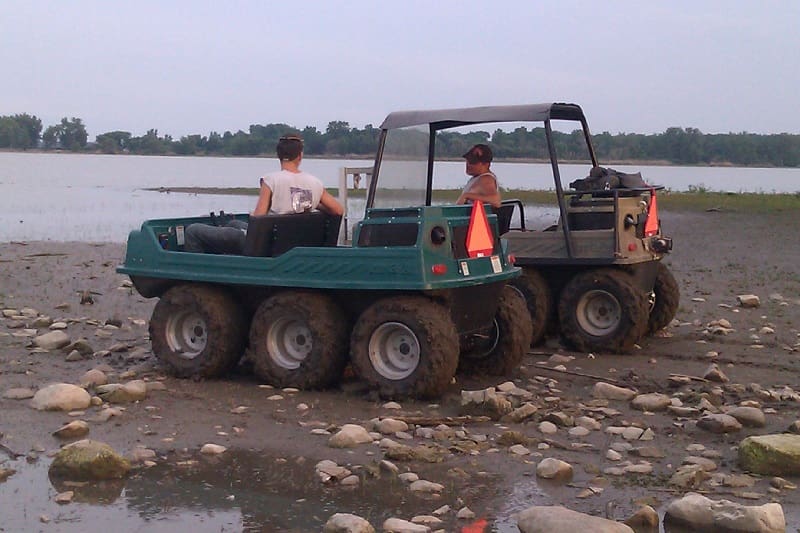
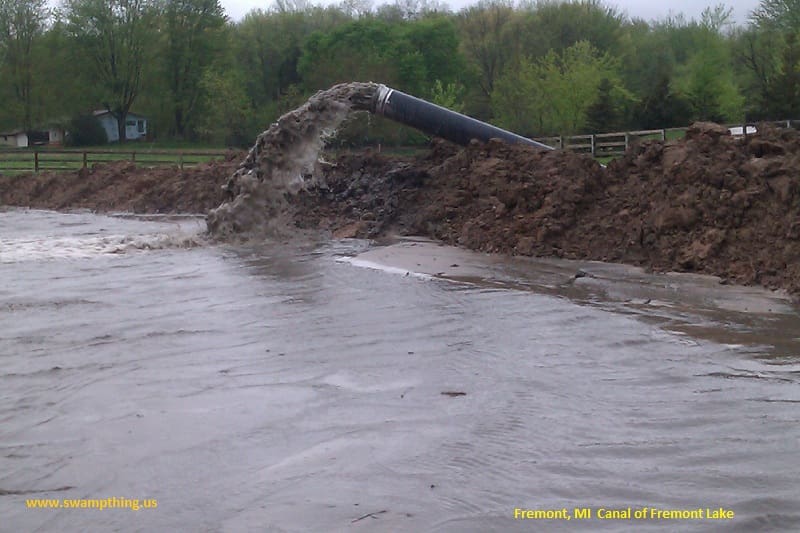
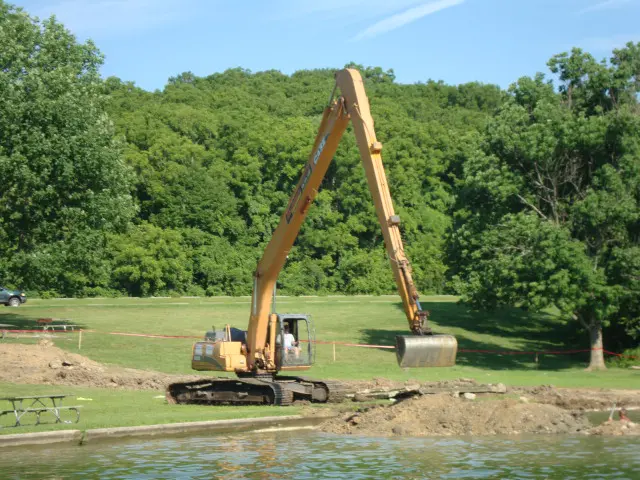
Important for You to Read: Weed Harvesting vs. Herbicides
Note: We recently removed 12 trailer loads of aquatic vegetation from a canal by weed harvesting. The trailer holds aquatic weeds in an approximate area of 22 feet long x 5 feet wide x 3 feet high. If you take this area and divide it into a cubic yard, it would be approximately 12.22 cubic yards of vegetation. A yard of mulch weighs roughly 300 to 500 pounds per cubic yard. Let's use (for the sake of argument) 300 x 12 cubic yards = 3,600 pounds. Now let's take the 12 loads x 3,600 pounds, this will give you 43,200. If weed is harvested, you are helping by removing a lot of vegetation mass and helping remove phosphates which promote further weed growth. Now, take that same scenario and treat these aquatic weeds 3 times a year and add all this decomposed vegetation to the bottom of your lake. You are overloading your lake/pond with too many nutrients and creating a mucky bottom in most cases. Now do this year after year, what is happening to your body of water!! One pound of phosphate can support 1100 pounds of algae growth. Look at the loads below.
How Do You Say It?
AQUATIC SERVICES, AQUATIC WEED SERVICES, AQUATIC WEED CONTROL, AQUATIC WEEDS REMOVAL, WEED CONTROL, Seaweed removal, AQUATIC WEEDS CONTROL AND REMOVAL, AQUATIC CONTROL, AQUATIC WEEDS, AQUATIC WEED CONTROL MANAGEMENT, AQUATIC WEEDS MANAGEMENT, AQUATIC WEED HARVESTER, WEED HARVESTING, WEED HARVESTER, MECHANICAL WEED HARVESTING, Seaweed Harvesting, AQUATIC WEED RAKE, AQUATIC WEEDS CUTTER, LAKE WEEDS, LAKE WEED, LAKE WEED HARVESTING, LAKE WEED REMOVAL, LAKE WEED CONTROL, LAKE WEED SERVICES, LAKE WEEDS KILLER, ORGANIC WEED KILLER, ORGANIC WEED CONTROL, AQUATIC WEED FABRIC, WEED CONTROL FABRIC OR AQUATIC WEED BARRIER. ANY WAY YOU SAY IT. Swampthing.us can meet all your AQUATIC CONTROL and DREDGING NEEDS! Call Us Today!
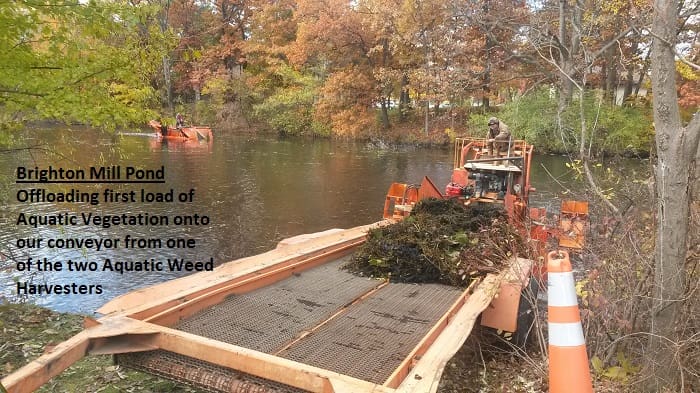
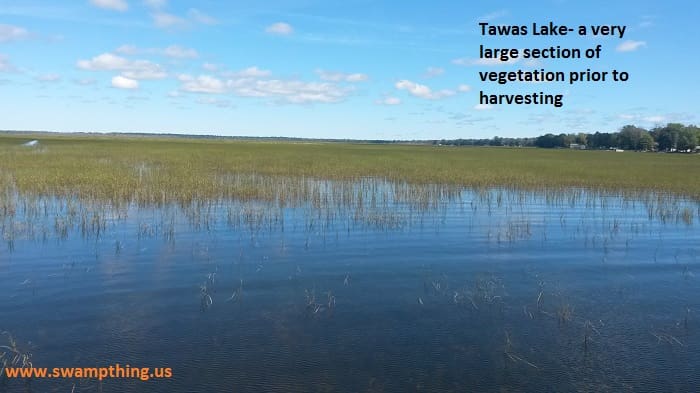
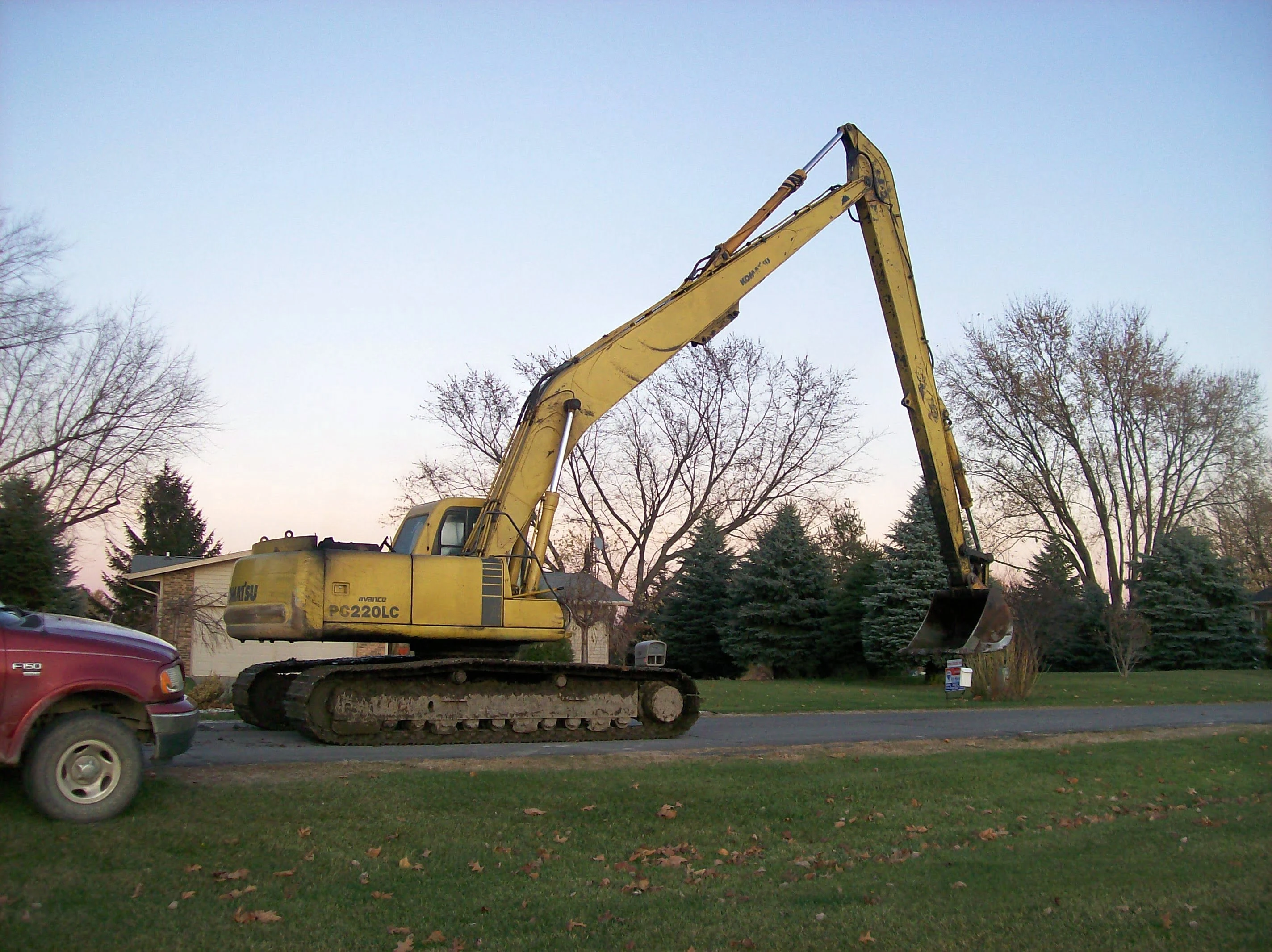
Watershed Management Programs
Proper Weed Control starts with good Watershed Management. We welcome anyone to attend Free Watershed Management Workshops. If you have a large group or Lake Association, we may hold a workshop specifically for your group. You will have an opportunity to ask questions on how to help improve your Lakes unique ecosystem.
We offer services to help improve your own residential Lakefront, to do your part: LakeScaping, Special Fertilizers for your lawn, Fall leaf fences, and leaf pickup, to name a few.
You influence what happens in your watershed, good or bad, by how you treat the natural resources--the soil, water, air, plants, and animals. What happens in your small watershed also affects the larger watershed downstream. It affects abundant weed growth, poor water quality, or poor health of fish and other wildlife. It can affect your health. There are many things you and your watershed community can do to keep your watershed healthy and productive.
Lake Weed Removal and Lake Weed Control. Let American Dredge and Aquatic Weed Control Company develop an Aquatic Weed Management program for you using Aquatic services and Aquatic weed control methods: Aquatic Weed Harvesting, Lake weed removal with a Hydro-rake, applying a Weed Control Fabric or Weed Barrier Fabric with sand/pea stone or for serious projects using dredging equipment for dredging a Lake or Dredging a Pond. You can also contact us for Canal Dredging and Channel Dredging projects, contact a dredging company that cares about your pocketbook, Aquatic Weed Control or Dredging Information MI, IN, OH, WI, IL, KY, TN, AL, NC, SC, GA, MN, IA, CO, TX contact us 1 (855) 305-0233 or email at manager@swampthing.us.
Lake Scaping-Organic Weed Control
A combination of properly designed erosion control techniques using native plant materials can provide a stable shoreline in most stream and lake shoreline conditions. In addition to the aesthetic appeal provided by a diverse mix of native species, a naturally stabilized shoreline can provide a habitat for a variety of fish and wildlife species.
- Reduced Erosion and Sedimentation; Native plant buffers reduce soil erosion and sedimentation by holding soil in place with deep-rooted native plants and reducing wave energy.
- Reduce Undesirable Nutrients; o Phosphorus and nitrogen feed aquatic plants and algae. Native plant buffer strips capture and absorb nutrients before they can enter waterways, reducing waterfront nuisance vegetation and algae.
- Deter Geese.; Native plant buffer strips provide a natural deterrent for geese.
Benefits of Native Plant Shoreline Buffers include:
- Enhanced Visual Appeal
- Improved Fish and Wildlife Habitat
- Reduced Maintenance Cost
Plan ahead because certain materials/projects may need a permit reviewed by your local DEQ or DNR.

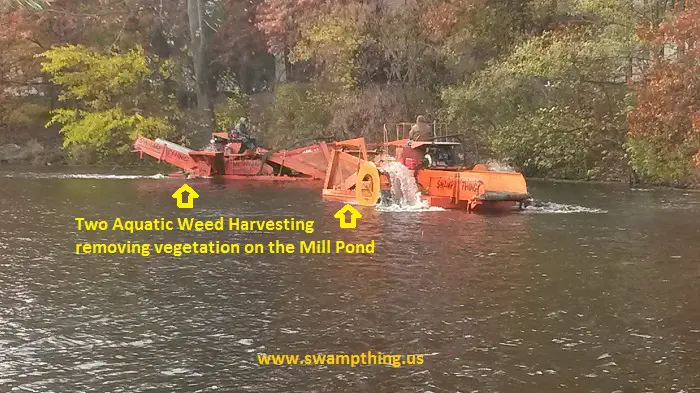
Fall Clean Up:-Reduce Aquatic Weeds
Our company will install leaf fences and pick up leaves in the fall to prevent the leaves from building up in your canalways and lakefronts. When the leaves accumulate in your lake, that is added nutrients to support thriving weed growth for the next season. Also, this creates added biomass to the lake floor. Your lake is slowly disappearing.
Use the Correct FERTILIZER on Your Lawn Lakefront
Turfgrasses maintained around lakes and ponds can be of great benefit to the water by providing a buffer zone for the filtration of runoff materials and protection against erosion and soil sedimentation. It is critical for turf managers to maintain waterfront areas with special care to prevent the maintenance activities from negatively impacting the water, which we hold in such high regard in Michigan.
A soil test is crucial on sites close to water to evaluate the phosphorus level. Phosphorus is a key contaminant of surface water and is usually the most limiting factor in aquatic weed growth. Most soils in Michigan have adequate phosphorus levels for supporting lawn turf.
Let's examine the classical Nitrogen - Phosphorus - Potassium (N-P-K) fertilizer mix for water impact. Nitrogen and phosphorous are the main factors in water quality issues, with phosphorus clearly the major concern. Potassium movement and impact are minimal and not considered a problem. Nitrogen is the most soluble and the most prone to leaching. It can enhance weed and algae growth, which has detrimental effects on the quality of the water. Phosphorous has the greatest impact on aquatic weed growth and is the most limiting nutrient in aquatic environments. The addition of phosphorous into these environments allows aquatic plants to take advantage of other elements. An MSU aquatic expert estimates that 1 pound of phosphorus could support 775 pounds of aquatic weed growth. Compared to nitrogen, phosphorus is not very soluble and gets bound tightly to the soil and thatch layers. It usually enters the water attached to the soil as a result of erosion.
Classical fertilizer mixes of N-P-K may be hard to justify around water because the soil phosphorous levels are most likely adequate. Test the soil routinely!!! If the phosphorous level is above 20 for the Bray P-1 test, there is no need to add more phosphorous.
Use a 5-10 foot buffer strip adjacent to the water to which minimal or no fertilizer is applied.
- Use a -0- phosphorous fertilizer (20-0-10) if P levels are adequate based on a soil test.
- Approximately 1–4 pounds of nitrogen per 1000 sq. ft. per year should be adequate in most areas.
- Use the lower nitrogen amounts for shaded areas.
- Use no more than ¾ pound/1000 sq. ft. of nitrogen per application.
- At least ¼ - 1/3 of the nitrogen should be in a slow-release form. These include the organic forms, sulfur-coated products, or IBDU.
- Don't begin spring application until 3 weeks after green-up.
- A general application sequence would be May, early July, September, and late October or November. For lower amounts, the July application could be eliminated.
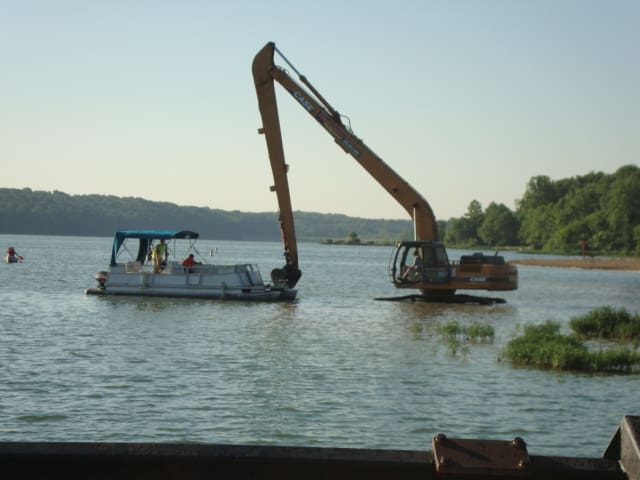
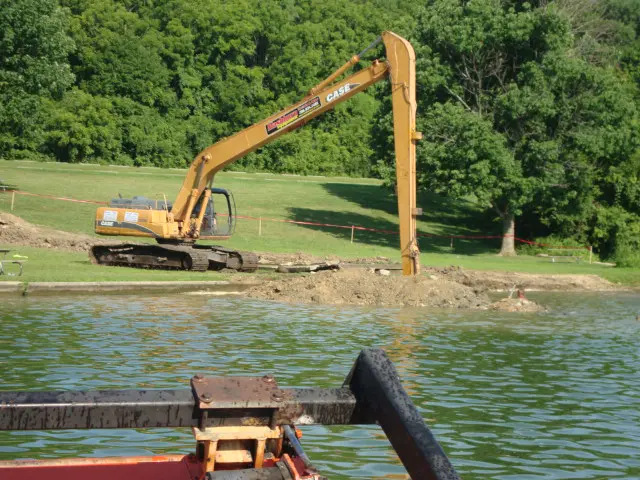

If Phosphorus is Essential for All Plants and Animals, Why is It Bad for the Lake?
Phosphorus is an essential nutrient in a plant or animal’s growth. It is therefore needed by the plants and organisms that live in the Lake. The problem occurs when more phosphorus than those plants and organisms need ends up in the Lake, disturbing the delicate nutrient balance that exists. Phosphorus stimulates growth, so when too much of it ends up in the lake, some plants and algae grow too quickly and thickly. In turn, the overabundance of these plants then absorbs much of the oxygen and sunlight needed by fish and plants below the surface waters. Additionally, the ultimate decomposition of these plants creates a toxic environment for other organisms. As a result, the Lake's normal ecosystem is dramatically altered. In addition, algal blooms are also a major deterrent to human enjoyment of the Lake as the murky green, sometimes smelly water is less than inviting for swimming, fishing, and boating.
What Can I Do to Lower Lake Phosphorus Levels? There Are Many Things Individuals Can Do to Reduce Phosphorus in the Lake
- Reduce or discontinue use of pesticides.
- Use phosphate-free dishwashing and laundry detergents.
- Clean up after your pets so that the waste does not run off directly into the lake untreated.
- Wash your car on grass rather than pavement, so the detergent can be filtered through the grass instead of running directly into the stormwater system and into the lake untreated.
- If you have a lawn, cut back on the amount of fertilizer you use. Cut only a third of the length of the grass with a sharp blade, leaving the cuttings to naturally fertilize the grass. If you must fertilize, use a low-phosphate fertilizer.
- If you live near or on the Lake, landscape your property with native plants that will provide a buffer between your lawn, garden, or road so as to filter out any pollutants including phosphorus before they reach the Lake. Roots are great filters. They also keep soil (which phosphorus likes to cling onto) in place.
Please remember Swampthing.us for all your needs for Aquatic Services and Aquatic Control. Let us be your first choice in Lake Weed Control, Mechanical Weed Harvesting, Dredging, Pond Liners, Pond Aeration, and Diffusers, and complete Aquatic Control of Lake Weeds
Email Us: manager@swampthing.us
Phone: 1 (855) 305-0233
